8 5.2 EDI in the Canadian Workplace
Learning Objectives
 After reviewing this information, you will be able to
After reviewing this information, you will be able to
-
-
- Quantify the diversity of the Canadian work environment
- Explain the barriers to instituting EDI in the work environment
- Explain the benefits of an inclusive work environment
- Articulate strategies to establish an EDI inclusive work environment
-
Equity, diversity, and inclusion (EDI) should be a welcomed concept in all parts of life, including the workplace. EDI is not simply a feel good concept; instead, EDI “is a mindset and approach that unites ethical management and high performance” (Bearman, n.d., para. 3) that results in many tangible benefits for organizations. Today, Canada is a multi-cultural society with businesses that operate in a multicultural world serving multicultural customers and audiences. Businesses that are not integrating practices, policies, and initiatives dedicated to promoting EDI have missed the train. In the workplace of today and tomorrow, EDI is ubiquitous with good business.
 In this unit we will look at the make-up of the Canadian work environment, attitudes towards EDI, and strategies that promote the adoption of EDI practices.
In this unit we will look at the make-up of the Canadian work environment, attitudes towards EDI, and strategies that promote the adoption of EDI practices.
An Overview of the Canadian Workforce
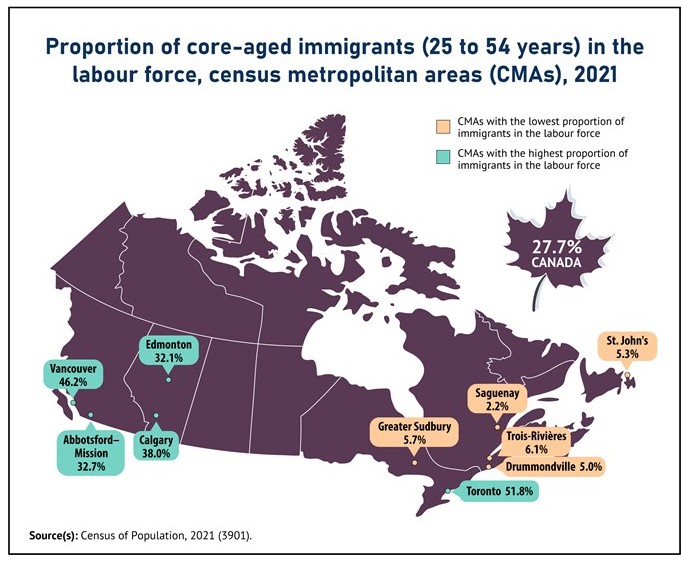
Ethnicity and Race
Let’s begin with an overview of diversity in Canada and the Canadian workplace. Canada is known to be a multicultural country primarily because of its immigration system. Accordingly, in 2021 “more than 450 ethnic or cultural origins” (“The Canadian Census”, 2022, para. 9) were present in Canada. Among these, three specific ethnic groups: South Asian, Chinese, and Blacks made-up 16.9% of Canada’s population (“The Canadian Census”, 2022, para. 12). This diversity in Canada’s general population is also reflected in its workforce from coast to coast to coast. Figure 5.2.1 presents a picture of Canada’s immigrant population in major metropolitan cities across the country. Edmonton, Calgary, Vancouver, Abbotsford-Mission, and Toronto being the cities that have the largest percentage of immigrant workers in their workforce. More than one-half of Toronto’s labour force, 51.8%, is composed of immigrants (Jobs in Canada, 2022).
Additional research tells us that the percentage of this population in the workforce is not a fleeting phenomenon. Instead, the percentage of Canada’s ethnic population is projected to grow to approximately 35% by 2036 (Martel, 2019).
Gender, Sexuality, Age, and Ability
As we’ve discussed in the previous chapter (see Unit 47), diversity is not simply about ethnicity or race. Diversity also includes considerations of gender, sexuality, age, and ability among other groups. A workplace that is committed to EDI should employ a workforce that reflects the wider umbrella of the Canadian population. The following statistics will provide insight into the broader spectrum of Canada’s workforce diversity umbrella.
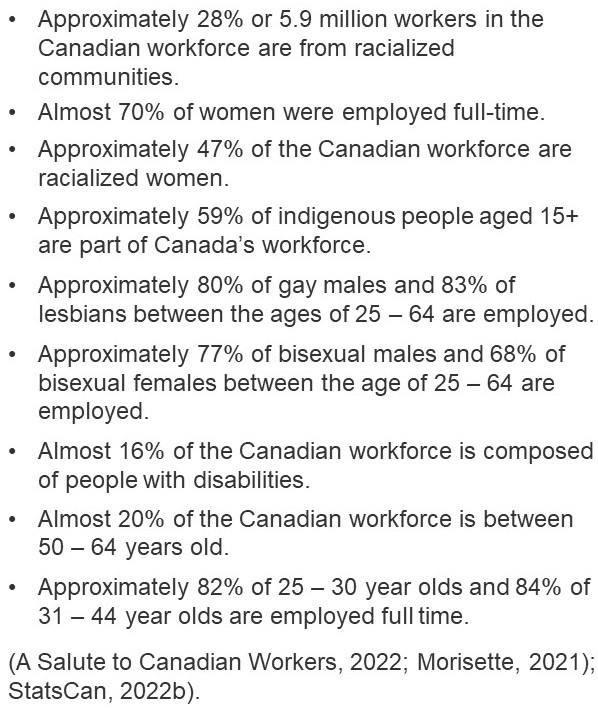 |
 |
Figure 5.2.2 tells a story of a Canadian workforce that is diverse and inclusive of a broad spectrum of Canadians. However, despite the many positive effects diversity and inclusion has on businesses, the workplace continues to struggle with welcoming diversity and treating its workforce equally (see Figure 5.2.3). In a recent study, 20% of women reported experiencing some form of gender discrimination in the hiring process, while 61% of all employees in the same study said they witnessed or were the recipient of discriminatory behaviour at work (Mrkonjik, 2022). Moreover, in Unit 47 we already discussed the findings that candidates with ethnic and racially identifiable names (e.g. Yusuf or Dequan) and candidates 50 years old and older (Mrkonjik, 2022) are less likely to be given the opportunity to even interview for a position. Clearly there is much work to be done to achieve true inclusivity in the workplace.
EDI and Power in the Workplace
A final and important area in helping to understand the Canadian work environment is to review the management and leadership structures within organizations. Who are the decision makers? Who sets and influences policies and practices? Who establishes organizational culture? According to Singh (2021), in the Canadian and the American context, “businesses still struggle to achieve diverse representation at all internal management levels”.
In Canada, white males were twice as likely as both men and women in racialized groups and white women to hold decision making positions and positions of power within organizations (Statistics Canada, 2022d). Moreover, a recent LinkedIn Learning (n.d.) study reported that approximately 93% of Fortune 500 companies do not have women CEOs, and of the top 50 most valuable public companies in the United States, only 8% of top executives are Black. In fact, according to the same report, a minimum of eight companies had no Black employee in a management position (LinkedIn Learning, n.d.). Thus, despite the push by many companies in Canada and the U.S. to implement EDI initiatives, the established power structure continues.
The real power to influence and shape the business environment remains in the hands of white males. Figure 1.3 offers similar findings on the distribution of power and influence on the boards of major Canadian businesses.
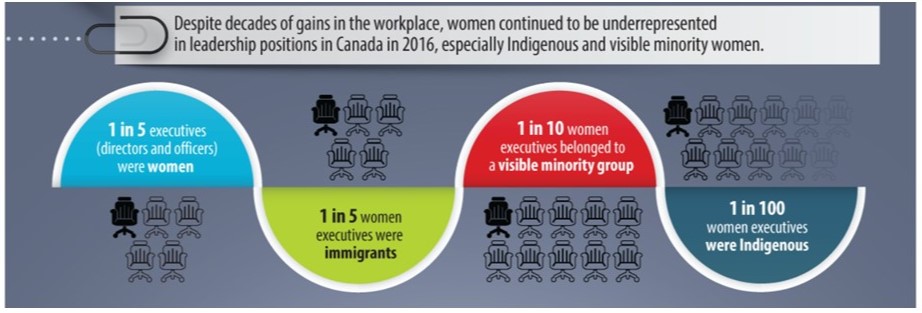
An overview of the Canadian workforce strongly indicates that interacting with people from diverse groups is no longer optional. However, understanding how to create work environments that embrace and foster EDI is not automatic. Making the situation more complicated is the tendency of members from dominant groups to be less willing to do the work and make the changes necessary to embrace EDI. A recent report, noted that only 27% of white workers believe that EDI initiatives are important in the work environment (Mrkonjic, 2022).
Further, according to Ahrndt (2020),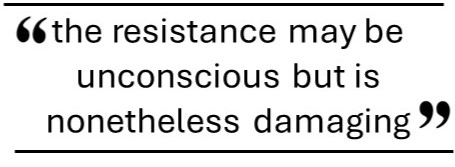 this resistance to EDI initiatives often creates work environments where individuals from nondominant groups are expected to comply or adapt to the behaviours and attitudes of the dominant group. For example, “women in corporate environments may adapt masculine communication patterns, people who are gay or lesbian may self-censor and avoid discussing their same-gender partners with coworkers, and people with nonvisible disabilities may not disclose them in order to avoid judgment” (Ahrndt, 2019, p. 22).
this resistance to EDI initiatives often creates work environments where individuals from nondominant groups are expected to comply or adapt to the behaviours and attitudes of the dominant group. For example, “women in corporate environments may adapt masculine communication patterns, people who are gay or lesbian may self-censor and avoid discussing their same-gender partners with coworkers, and people with nonvisible disabilities may not disclose them in order to avoid judgment” (Ahrndt, 2019, p. 22).
For many in dominant groups, the resistance may be unconscious but nonetheless damaging. Review the following video, Equality, Diversity, and Inclusion: Open Your Minds (2018), for an overview of the many damaging effects created by the resistance to EDI in the work environment.
Implementing EDI in the Workplace
Despite the many positive impacts EDI has on workplace culture, productivity, and profits, there remains resistance to implementing EDI policies in many work environments. This resistance is one of the many puzzling attitudes against the overwhelming evidence that EDI works. Below are just a few of the many benefits companies experience from implementing EDI policies and initiatives.
- Diverse companies earn 2.5x higher cash flow per employee.
- Organizations in the top quartile for ethnic diversity have a +36% likelihood of financial outperformance.
- Inclusive teams are over 35% more productive.
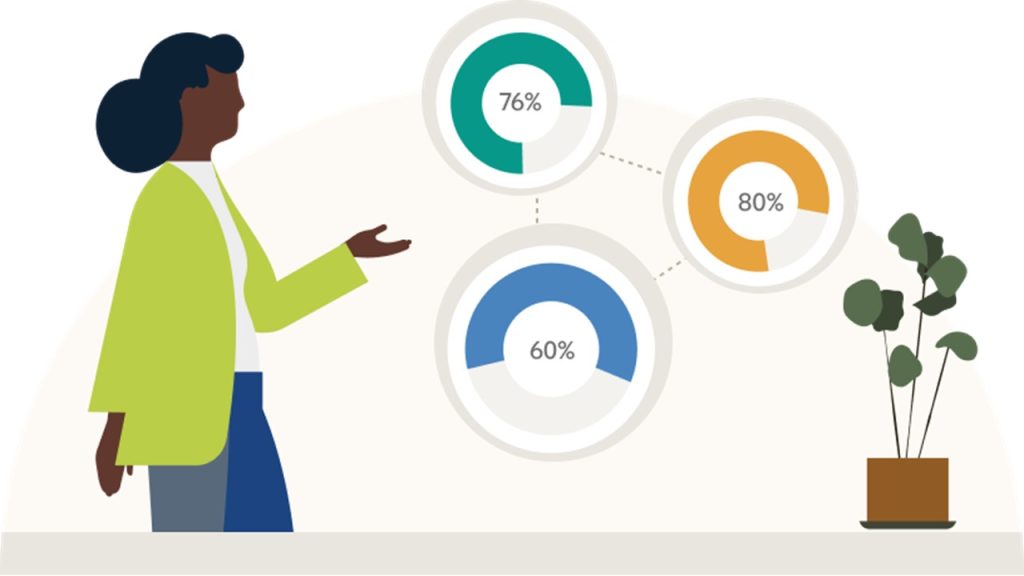
Figure 5.2.4 The number of employees who think diversity is important (Linkedin Learning, n.d.). - Diverse teams make better decisions 87% of the time.
- Organizations in the top quartile for gender diversity have a +25% likelihood of financially outperforming their peers.
- Companies with a EDI team were 22% more likely to be seen as “an industry-leading company with high-caliber talent”.
- Seventy-one percent of employers say diversity practices have a positive impact on their company.
- Seventy-six percent of employees and job seekers said diversity was important when considering job offers.
- Eighty percent of survey respondents said they want to work for a company that values EDI issues.
- The younger generations—millennials and older Gen Z—prefer diverse companies to buy from and work for. (Linkedin Learning, n.d.)
So, what do the numbers tell us? Companies with EDI initiatives receive financial benefits and create environments that employees want to work in, are more productive in, and are more innovative in. The good news is that more and more companies seem to be waking up to these benefits. A recent report noted that “45% of learning & development professionals planned to implement DEI programs in 2022” (Linkedin Learning, n.d.), an increase of 11% from the previous year, and between 2015 – 2017, 23 % more CEOs were implementing hiring practices targeting ‘talent diversity and inclusiveness” (Mrkonjic, 2022).
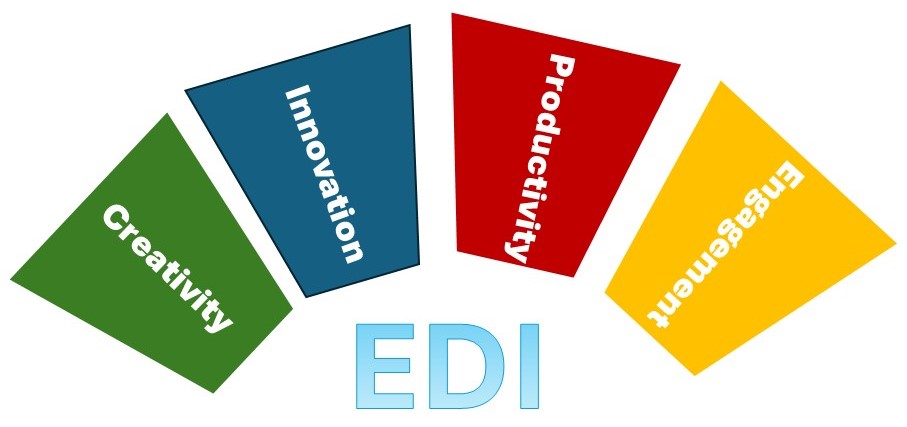
Some of the more effective policies that CEOs, hiring managers, and human resource departments are implementing to create diverse, equitable, and inclusive work environments are discussed briefly below (Linkedin Learning, n.d.; Mrkonjic, 2022).
Strategies for Workplace Inclusivity
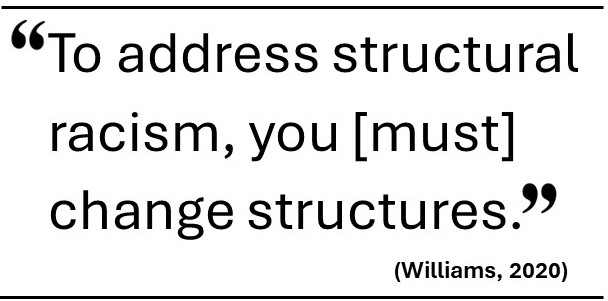 Changing a behaviour we don’t like or establishing a new behaviour we want is a difficult process. It takes weeks, months, and sometimes many years to permanently change or establish a new pattern of behaviour. The same principle holds true for changing organizational culture and structures. In fact, such systemic changes in organizations are often more challenging to implement and sustain (Williams, 2020). Research suggests that changes can be made to three organizational systems: recruitment, retention, and promotion, to foster work environments reflective of EDI. (Diversity in Canadian Workplaces, n.d; Williams, 2020).
Changing a behaviour we don’t like or establishing a new behaviour we want is a difficult process. It takes weeks, months, and sometimes many years to permanently change or establish a new pattern of behaviour. The same principle holds true for changing organizational culture and structures. In fact, such systemic changes in organizations are often more challenging to implement and sustain (Williams, 2020). Research suggests that changes can be made to three organizational systems: recruitment, retention, and promotion, to foster work environments reflective of EDI. (Diversity in Canadian Workplaces, n.d; Williams, 2020).
Recruitment
Recruiting and hiring the right talent is crucial to the survival of every business. Without the right talent and knowledge base, an organization cannot fulfil its objective. Many of the statistics shared earlier in this chapter indicate that a diverse workforce supports the primary aim of organizations to be successful. A few recruitment strategies that will allow organizations to attract and hire a diverse workforce are discussed below.
- Ensure job descriptions focus on the skills required, use inclusive language, and omit unnecessary jargon that may not be understood by a diverse audience.
- Utilize AI to screen out information from applicant resumes that may suggest an applicant is part of a particular group (e.g. screen out names).
- Ensure everyone on the interview committee has undergone unconscious bias training. According to the report, Diversity in Canadian Workplaces Initiative (n.d.), the need to ensure those responsible for hiring had “unconscious bias raining emerged as consistent areas of focus” (p. 3) in discussions with a wide group of employers and employees.
- Widen the pool of potential job applicants by establishing relationships with community organizations that services underrepresented and diverse groups.
- Implement evidence and metrics-based tracking system to keep track of who survives the interview process. Knowing this information can help an organization make changes to ensure its recruiting process achieves the goal of inclusion.
(Diversity in Canadian Workplaces Initiative, n.d; Williams, 2020 ).

Retention
Retaining talented, trained, and experienced employees is a major concern for all business. Once hired, companies can utilize the following strategies to retain a diverse workforce.
- Change must start from the top. Therefore, provide management with the tools and training to develop a genuine understanding of the importance of diversity and inclusion.
- Depending on the size of the company, establish a position or a department dedicated to implementing, maintaining, and monitoring the progress of EDI initiatives and programs.
- Establish Employee Resource Groups dedicated to advocating for and responding to the needs of diverse groups.
- Encourage a culture of safe and open conversations about EDI to foster greater understanding and sense of inclusion among employees.
- Establish a baseline, then collect evidence and use metrics to track the effectiveness of EDI initiatives and policies.
(Diversity in Canadian Workplaces Initiative, n.d; Williams, 2020).
Promotion
Research tells us that power and influence in organizations continue to remain in the hands of white males and that the structures and processes that perpetuate this power imbalance are resistant to change (Diversity Among Board Directors and Officers, 2019; Singh, 2021; Statistics Canada, 2022d; Linkedin Learning, n.d.). Resistant to change though it may be, to achieve true inclusivity, board, management, and leadership positions must include representatives from diverse communities. The following are just a few strategies that may begin to shift this management and leadership power imbalance.
- Establish mentorship and coaching opportunities between senior management and underrepresented employee groups to facilitate a pathway to leadership and management positions.
- Use search firms that are run by and cater to underserved communities to widen the candidate pool and identify possible leadership, management, and board candidates.
- Implement a clear and transparent talent development plan and process.
- Use metrics to track the composition of boards, leadership, and management overtime.
(Diversity in Canadian Workplaces Initiative, n.d; Williams, 2020; Singh, 2021).
The following video, Why Corporate Diversity Programs Fail and Why Small Tweaks can Have Big Impacts (2020), provides a concise overview of barriers preventing companies from achieving true inclusion and strategies to overcome those barriers.
Conclusion
The Canadian workforce is diverse and getting more diverse as Canada continues to be a country that welcomes citizens from every part of the world. “Diversity if our strength” is not simply a phrase, but a fact backed up by statistics on all segments of the Canadian workforce. In this chapter, we discussed some strategies that organizations and businesses can implement to create truly diverse and inclusive work environments. However, on an individual level, what can you do? What role and responsibility do you have in transforming the Canadian workforce? Our next chapter on Decolonializing the Work Environment explores these very important questions.
References
Access Employment. (n.d.). Diversity in Canadian workplaces: The current state and future goals of D&I initiatives in Canadian workplaces. https://accesemployment.ca/wp-content/uploads/2021/08/Diversity-White-Paper.pdf
Ahrndt, S. (2020). Intercultural communication. Open Educational Resources Collection. 24. https://irl.umsl.edu/oer/24
Bearman, A. (n.d.). Chapter 1: Introducing workplace diversity. Creating a diverse and inclusive organizational culture. PalniPress. Retrieved February 5, 2024, from https://pressbooks.palni.org/diorgculture/chapter/chapter-1/
Linkedin Learning. (n.d.). Why is divesity and inclusion important: Diversity in the workplace statistics. https://learning.linkedin.com/resources/learning-culture/diversity-workplace-statistics-dei-importance#:~:text=Diverse%20companies%20earn%202.5x,decisions%2087%25%20of%20the%20time.
Martel, L. (2019). The labour force in Canada and its regions: Projections to 2036. Statistics Canada. https://www150.statcan.gc.ca/n1/pub/75-006-x/2019001/article/00004-eng.htm
Morissette, R. (2019). Chapter 2: Youth employment in Canada. Statistics Canada. https://www150.statcan.gc.ca/n1/pub/42-28-0001/2021001/article/00002-eng.htm
Mrkonjic, E. (2022). 21 eye-opening blind hiring statistics. GoRemotely. https://goremotely.net/blog/blind-hiring-statistics/
NV atCEPImperial. (2018). Equality, diversity and inclusion: Open your mind [Video]. Youtube. https://www.youtube.com/watch?v=Q6eqOBOqESM
Singh, S. (2021). Boards need real diversity, not tokenism. Harvard Business Review. https://hbr.org/2021/08/boards-need-real-diversity-not-tokenism
Statistics Canada. (2019). Diversity among board directors and officers [Infographic]. https://www150.statcan.gc.ca/n1/pub/11-627-m/11-627-m2021047-eng.htm
Statistics Canada. (2022a). Jobs in Canada: Navigating changing local labour markets. The daily. https://www150.statcan.gc.ca/n1/daily-quotidien/221130/dq221130b-eng.htm
Statistics Canada. (2022b). Labour and economic characteristics of lesbian, gay and bisexual people in Canada. Just facts. https://www150.statcan.gc.ca/n1/pub/89-28-0001/2022001/article/00003-eng.htm
Statistics Canada. (2022c). Women’s full-time employment in Canada, 2007 to 2021 [Infographic]. https://www150.statcan.gc.ca/n1/pub/11-627-m/11-627-m2022058-eng.htm
Statistics Canada. (2023). A salute to Canadian workers. StatsCan+. https://www.statcan.gc.ca/o1/en/plus/4420-salute-canadian-workers
Williams, J. (2020). Why corporate diversity programs fail and why small tweaks can have big impacts [Video]. TedxMileHigh. https://www.ted.com/talks/joan_c_williams_why_corporate_diversity_programs_fail_and_how_small_tweaks_can_have_big_impact

